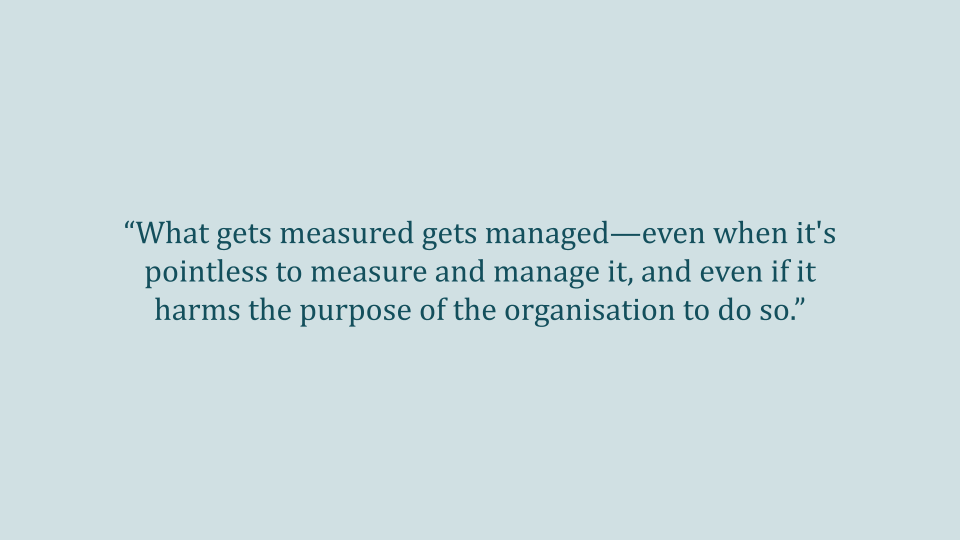If there’s one quote that’s particularly popular in management circles, it’s “what gets measured gets managed”—often misattributed to famous management consultant Peter Drucker. First, Drucker never said this; second, he actually didn’t believe such a thing; third, the idea is flawed.
A long game of telephone
The idea probably originated from a paper published in 1956 by V. F. Ridgway, in which he was making the case that we should be more careful when using quantitative measures:
“Quantitative measures of performance are tools, and are undoubtedly useful. But research indicates that indiscriminate use and undue confidence and reliance in them result from insufficient knowledge of the full effects and consequences. Judicious use of a tool requires awareness of possible side effects and reactions. Otherwise, indiscriminate use may result in side effects and reactions outweighing the benefits (…) The cure is sometimes worse than the disease.”
The title of the paper, Dysfunctional Consequences of Performance Measurements, makes Ridgway’s position pretty clear. As journalist Simon Caulkin put it: “What gets measured gets managed—even when it’s pointless to measure and manage it, and even if it harms the purpose of the organisation to do so.”
Somehow, a long game of telephone resulted in a truncated version of the idea, where the most important part about being careful with measurement was forgotten. As for Drucker, this is what he really said in The Effective Executive: “Moreover, because knowledge work cannot be measured the way manual work can, one cannot tell a knowledge worker in a few simple words whether he is doing the right job and how well he is doing it.” Not quite the same as the popular quote, is it?
Measurement myopia
The problem is not so much with measurement in general; it’s with blind measurement and the belief that measurement is intrinsically good. Measurement myopia can lead to several issues at the individual, corporate, and societal levels.
- The wrong metrics can lead to unintended consequences. This is made evident in studies of Soviet management: “The output of an entire plant may be allowed to fall off in order to create conditions under which one worker can make a production record, when the importance of such a record is considered greater than over-all plant production.” Another famous example is when the British government offered a bounty for every dead cobra in Delhi. Enterprising started breeding cobra snakes to get the bounty, leading to even more cobras in the city.
- People are more than numbers. Much of a company’s success relies on human factors which are hard—sometimes impossible—to measure. As neuroeconomist Paul Zak puts it: “When it comes to people, not everything that goes into being effective can be captured by some kind of metric. Not enthusiasm. Not alignment with an organisation’s mission. Not the willingness to go above and beyond.”
- When a measure becomes a target, it ceases to be a good measure. Goodhart’s law shows that measures can distort incentives and derail a company from its goals. This is also true at the individual and societal levels. “When a feature of the economy is picked as an indicator of the economy, then it inexorably ceases to function as that indicator because people start to game it,” writes Professor Mario Biagioli.
Does it mean we should not measure anything? V. F. Ridgway had a more nuanced view, recommending an approach that’s mindful of the motivational and behavioural consequences of performance measurement.
Mindful measurement
In many cases—such as revenue, churn rate, readership—businesses do need metrics to measure their performance. But many performance indicators do not neatly align with a specific metric, and should not be artificially forced to fit into a measurement model. Some rules of thumb can help determine how to measure performance in a way that’s mindful of such cases.
- People-first management. Talking about the role of the manager, Drucker said: “Your first role is the personal one. It is the relationship with people, the development of mutual confidence, the identification of people, the creation of a community. This is something only you can do. It cannot be measured or easily defined. But it is not only a key function. It is one only you can perform.” Don’t hide behind numbers to measure people’s performance. Have human-to-human conversations.
- Metacognition. Instead of keeping on applying the same measures of performance over and over, make sure to reflect on the way your current measurement systems impact the way you think and work. How are these measures impacting your incentives? In what ways could these measures be gamed? Is there any potential for second-order consequences?
- Non-measurable performance indicators. Make your peace with the fact that some performance indicators simply cannot be measured. Innovation, creativity, enthusiasm, expertise… Are all impossible to truly measure. You could of course use an indirect measure (which many companies do by administering tests during the hiring process), but do not confuse the incomplete—and potentially flawed—measure with the actual factor.
Remember: Peter Drucker never said “what gets measured gets managed”, and measurement myopia can hurt your business by leading to unintended consequences, ignoring human factors of performance, and distorting incentives. Be mindful when measuring your performance, and accept that some factors simply cannot be measured.

